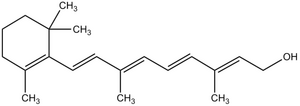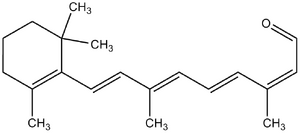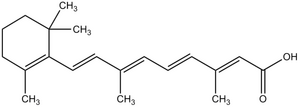Vitamine A
Vitamin A includes retinol, retinal and retinoic acid. It is created in the body from β-carotene and some other carotenoids. Bile secretion is necessary for resorption. Carotene is transported to the liver, where it is metabolized to vitamin A and stored. Zinc is needed to mobilize vitamin A. In the blood, it is transported to RBG (retinol binding globulin). It is reduced in retinitis pigmentosa , proteinuria and a low-protein diet.
Vitamin A is needed for stabilization of membranes, maturation and differentiation of epithelia, integrity of skin and mucous membranes, keratinization, support of immune reactions, production of mucus, metabolism of bones and teeth, development of the placenta , spermatogenesis , it is an important precursor of rhodopsin . Deficiency or excess leads to rupture of lysosomal membranes and release of hydrolases.
Beta carotene, in addition to being a precursor of vitamin A, has an antioxidant and anti-oncogenic effect (it is used in the prevention of the graduation phase of the carcinogenic mechanism, reduces the risk of lung cancer).
Source[edit | edit source]
Vitamin A as such is only found in animal foods. The richest source is the liver, there is relatively little of it in yolks, fats and meat. The source of beta carotene is green, red or orange vegetables and fruits.
Daily recommended dose for adults according to DACH 2000[1] je 1 mg of retinol equivalents. Pregnant and lactating women have a higher need.
Beta carotene to retinol equivalent ratio: previously the beta carotene to retinol equivalent ratio was 6:1. Based on studies on the amount of carotenes needed to prevent night blindness if carotenes are the main source of vitamin A, the American IOM changed this ratio to 12:1.[2]
This means that:
- in the food composition tables, which are based on the original 6:1 conversion, the vitamin A content in the food is overestimated;
- population intake of vitamin A is lower than expected.
Deficit[edit | edit source]
Deficiency from food is rare in Europe with normal eating habits, it can occur in disorders of fat absorption (e.g. celiac disease , pancreatic dysfunction).
On a global scale, vitamin A deficiency ranks among the most significant malnutrition: in developing countries, it is the most common cause of blindness in children and contributes to the death of a significant number of children from common infections, since already subclinical deficiency reduces immunity.[3]
Clinical manifestations
- Eye disorders - xerophthalmia: Day blindness (hemeralopia, wolf-like darkness), reversible xerosis conjunctivae (conjunctivae dry and thicken), silvery triangle-shaped Bitot spots appear first. Irreversible changes may follow: softening of the cornea (keratomalacia) and ulceration that heals with a scar.
- Immunity disorder - reduced resistance to infections.
- Epithelial changes of various organs – keratinizing metaplasia, dry scaly skin, follicular hyperkeratosis ( Morbus Darier – involvement of the skin of the face, neck, buttocks and extensors – pattern of sprinkled flour), metaplasia of the epithelium of the larynx – hoarseness; of the lower respiratory tract – the epithelium dries up and peels off → it can clog the bronchioles; metaplasia of the urinary tract epithelium predisposes to pyuria and hematuria; the vaginal mucosa is also dry; hair without shine.
- Other changes are also described, but since the affected people usually also have other deficiencies, the exact role of vitamin A is not clear.[4]
For assessing population status of vitamin A supply, assessment of incidence of night blindness and, more recently, plasma retinol level <0.70 μmol/l are used.[3]
Excess[edit | edit source]
Manifestations of hypervitaminosis occur only after preformed vitamin A. Retinoic acid is teratogenic. Therefore, during the first trimester of pregnancy, pregnant women should not consume liver (the richest source of vitamin A), which can contain very high amounts of retinol.[1]
Ointments with retinoids (for psoriasis, etc.) can be a dangerous source of overdose. Damaged children can be born to mothers treated with ointments even 2 years after the end of the treatment (Author not given!).
Acute hypervitaminosis is manifested by intracranial hypertension - vomiting, drowsiness, bulging of the large fontanel and/or a picture similar to an intracranial tumor ( pseudotumor cerebri ) - papilledema, cranial nerve palsy. It occurs after a dose in an adult >100x in a child >20x exceeding the recommended dose (food supplement, polar bear or shark liver).
Chronic hypervitaminosis - loss of appetite, nausea, vomiting, weight loss, diarrhea, alopecia , bleeding, bone fragility, hepatotoxicity (hepatomegaly and other symptoms of liver disorders). It occurs after weeks or years of consumption >10 times the recommended dose.
The upper limit of daily long-term safe intake for adults is 3 mg of vitamin A according to DACH 2000[1].
Administration of high doses (up to 10 mg) of beta carotene appeared to be harmless in large epidemiological studies, but in other studies there was an increase in the incidence of lung cancer in smokers after doses of 20-30 mg.
Caroteneemia[edit | edit source]
After long-term excessive consumption of carrots or other fruits and vegetables rich in carotene, a yellow discoloration of the skin occurs - carotenemia - a benign condition, because the conversion of carotene to vitamin A is slow. It differs from jaundice in that the sclera and mucous membranes are not yellow. Hypothyroidism, diabetes mellitus, liver and kidney disease can be associated with carotenemia due to a disorder in the conversion of beta carotene - but it is not an excess from food. [5]
Links[edit | edit source]
Related articles[edit | edit source]
External links[edit | edit source]
References[edit | edit source]
- ↑ a b c Deutsche Gesellschaft für Ernährung, Österreichische Gesellschaft für Ernährung, Sweizerische Gesellschaft für Ernährungforschung, Sweizerische Vereinigung für Ernährung. . Referenzwerte für die Nährstoffzufuhr (DACH). 1. edition. Frankfurt am Main : Umschau/Braus, 2000. 216 pp. ISBN 3-8295-7114-3.
- ↑ PANEL ON MICRONUTRIENTS, – SUBCOMMITTEES ON UPPER REFERENCE LEVELS OF NUTRIENTS AND OF INTERPRETATION AND USE OF DIETARY REFERENCE INTAKES, – STANDING COMMITTEE ON THE SCIENTIFIC EVALUATION OF DIETARY REFERENCE INTAKES,. Dietary Reference Intakes for Vitamin A, Vitamin K, Arsenic, Boron, Chromium, Copper, Iodine, Iron, Manganese, Molybdenum, Nickel, Silicon, Vanadium, and Zinc. 1. edition. Washington D.C : National Academic Press, 2002. 800 pp. ISBN 978-0309072908.
- ↑ a b World Health Organization. . Global prevalence of vitamin A deficiency in populations at risk 1995–2005 [online] . 1. edition. Geneva : World Health Organization, 2009. 55 pp. Available from <http://apps.who.int/iris/bitstream/10665/44110/1/9789241598019_eng.pdf,>. ISBN 978-92-4-159801-9.
- ↑ SOMMER, A. Vitamin A deficiency and its consequences [online] . 1. edition. Geneva : WHO, 1995. 69 pp. Available from <http://whqlibdoc.who.int/cgi-bin/repository.pl?url=/publications/1995/92415447783_eng.pdf>. ISBN ISBN 92 4 154478 3.
- ↑ KARTHIK, SV. , et al. Carotenemia in infancy and its association with prevalent feeding practices. Pediatr Dermatol. 2006, vol. 6, p. 571-3, ISSN 0736-8046.
References[edit | edit source]
- BENEŠ, Jiří. Studijní materiály [online]. [cit. 2010]. <http://jirben.wz.cz>.
- BENCKO, Vladimír. Hygiene. 2. edition. 2002. ISBN 80-7184-551-5.



